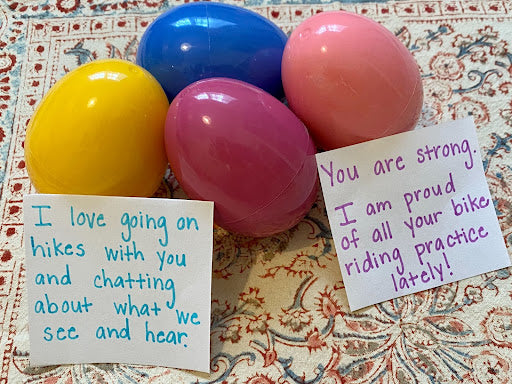Playful Alternatives to the Traditional Egg Hunt


Here are a few of our favorite ways to reuse fillable Easter eggs, long after the Easter Bunny’s come and gone. You’ll find something for everyone on this list: egg hunts to support early literacy skills, simple ways to express love and gratitude, active invitations for pretend play, and strategies to help extend family play sessions.

Letter Hunt
Choose one specific word to hide. We love starting with one family member’s name! Write the individual letters of this word/name on pieces of scrap paper and tuck inside separate eggs. If your child’s name has 6 letters, you’ll hide 6 different eggs, each containing one letter. Invite your child to search for the letters, unscramble them and figure out which word/name was hidden. Older children can hide new words for younger siblings or parents!
For toddlers and preschoolers who are working on letter awareness, simply hide meaningful letters instead of full words. First initials are a great place to start! “I’ve hidden 4 eggs with different letters inside. There is one egg for each person in our family. Here’s a list of the letters we’re looking for! These are the letters at the beginning of our names: V for Violet. H for Henry. M for Mama. D for Dada.”

Love Note Hunt
Write notes of gratitude, love, or affirmation and tuck inside individual eggs. If you have more than one child, everyone can search for an assigned egg color. The messages inside should be personal notes intended for a specific child. “Violet, you can search for the blue eggs. Henry, please search for the purple eggs. You’ll find special notes inside, just for you!”
Here are some examples of what you might tuck inside:
“Thank you for holding the door open for me when my hands are full.”
“You are strong. I’m proud of all your bike riding practice lately.”
“I love going on hikes with you and chatting about what we see and hear.”

“Let’s pretend!” Hunt
Give your egg hunt an active, imaginative twist! Brainstorm actions or pretend play prompts for your child to bring to life. Write or illustrate these suggestions and tuck inside individual eggs.
Here are a few ideas to get you started:
Sway like a tree, moving with the breeze.
Flap your arms gently and fly like a butterfly.
Crawl like a caterpillar, searching for yummy green leaves.
For young toddlers, you may want to stick with a particular theme, such as familiar animals. Within each egg, you can hide simple drawings of different animals for your child to act out.

Puzzle Hunt
This egg hunt is perfect for the puzzle lovers in your life! Use small puzzle pieces from existing puzzles or draw your own illustration on a piece of cardboard and cut into puzzle pieces. For a Puzzle Hunt, it’s helpful to let your children know how many eggs you’ve hidden. Be sure to consider your child’s age and attention span. Can you fit more than one puzzle piece per egg to shorten the search? You can also begin working on a puzzle with your child and let them know you’ve hidden the remaining pieces in eggs around the house!

Loose Parts Hunt
Fill individual eggs with different household or natural materials that can be used with play dough. For example, one egg might be filled with buttons. Some of our favorite loose parts include: pebbles, plastic bottle caps, corks, tiny sticks, pieces of pipe cleaners or cardboard straws. (Please be mindful of choking hazards when it comes to young toddlers!) Place a large ball of playdough in front of each child and explain, “Today we’re going to search for eggs filled with all different materials. We get to use these materials with our play dough! We can collect all 6 eggs before we play or experiment with each material as soon as we find it. What’s your plan?”
Recent Articles
-
Playful Primer 10 Must-Have Toys for Your Next Backyard BBQ
Summer is just around the corner and we're ready for it! From backyard BBQs to neighborhood park outings, we've discovered...
read more -
Playful Primer Tips & Toys to Support Group Play Experiences
Catching a glimpse of children happily engaged in pretend play is like witnessing pure magic. Ever wonder how closely you...
read more -
Playful Primer 5 Ways to Strengthen the Bond Between Siblings
“I’ll take care of the bike. You take care of each other.” This is what I said to my children...
read more
